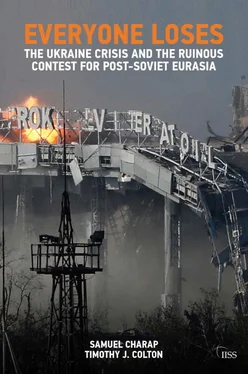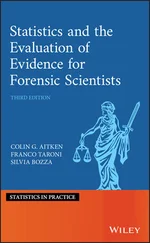Nationwide, the country has a new president (Petro Poroshenko, elected in May 2014) and a new parliament (elected in October 2014). But politics have become radicalised, and the state has been weakened, including by loss to volunteer paramilitary battalions of its monopoly over the use of force. The authorities are committed rhetorically to economic and political reform; results have been dilatory and quarrels over policy and patronage have abounded. Ukraine did sign the agreement with the EU that Yanukovych put on ice in 2013, but any pay-offs lie well in the future and there is no possibility of Ukraine becoming a full member of the bloc for many years to come, if ever. Ukrainian GDP slid by 7% in 2014 and another 10% in 2015, and that is counting production in areas no longer controlled by the central government.
The other actors in the ongoing saga have suffered less, but are certainly worse off than they were before the crisis began. Russia has gained some territory, true, but has paid dearly in economic terms and in international standing. The war footing and Western sanctions have weakened liberal impulses and strengthened conformist pressures within the polity while adding to the hyper-personalisation of political life around Putin. The economic downturn that has ensued, while not an exclusive result of Ukraine-related turbulence and Western sanctions (falling oil prices have been more debilitating), has only made things worse. Russia shows no inclination to annex the Donbas but has had to shell out tens of billions of roubles to ease its misery. Crimea, now de facto incorporated into the Russian state, will burden the treasury in the coming years, and Western sanctions and cut-offs in trade with and supply of irrigation water and electric power from the Ukrainian mainland have made life difficult for inhabitants of the peninsula.
The EU and the US, while less acutely affected, have not come out unscathed. For Europe, the crisis is possibly a direct threat to its security and is a very real, and very costly, policy quagmire. The EU’s Eastern Partnership, of which the agreement with Ukraine is an integral component, was intended to create a band of stable and prosperous countries along the Union’s borders. Ukraine, the largest neighbour, is today anything but stable and prosperous, and the EU has felt compelled to sink billions of euros into keeping it afloat. The sanctions and Russian counter-sanctions have hit European economies at a time when they can ill afford it. And the Ukraine gas-transit corridor is under perpetual threat of shut-off, jeopardising much of the broader EU–Russia gas trade. Washington for its part has felt required to bolster deployments and military expenditures in Europe in the context of tight budgets and competing demands from the ‘pivot’ toward the Asia-Pacific and the turmoil in the Middle East. The complete breakdown in US–Russia relations, which were bad to begin with, stands in the way of efforts to address all manner of global challenges.
In sum, the Ukraine crisis has catalysed a negative-sum political interaction. All of the parties to it, in our view, are worse off than before it began.
The central claim of this book is that the negative-sum outcome we behold today is a product of zero-sum policies pursued by Russia, the US and the EU. These developed fitfully in the first decade and a half after the Cold War but dramatically intensified thereafter. Russia and the West implemented policies toward the states of post-Soviet Eurasia that aimed to extract gains at the other side’s expense, without regard for overlapping or shared interests. Neither invested serious effort in the task of outlining or even contemplating a cooperative regional order that all parties could accept. The result has been not only a deepening east–west divide, but also dysfunction in the politics of the region’s states, where elites seek to milk this contestation to suit their own narrow, often pecuniary, interests.
Analysis done in the midst of a crisis generally tends to shed more heat than light. Much of what has been said and written about the Ukraine crisis is no exception. The roots of the crisis extend far beyond the political earthquake in Kyiv and Russia’s jarring response. This volume seeks to understand those events as an outcome of the recent, post-Soviet past. Its purpose is analytical, not normative. We do not seek to assign blame or to provide justification for any party’s actions, not only because making such judgements is not our role but also because no party to this chain of events has clean hands. Indeed, this book will demonstrate that constructive, considered policy and actions in this region were the exception, not the norm, for all sides.
Several alternative explanations of the Ukraine crisis – and particularly of Russia’s actions – have emerged since the watershed of early 2014. [4] Parsing through the various explanations is complicated by the wide range of justifications put forth by the participants themselves, particularly the leaders of Russia.
The most prominent describes the crisis as a result of Russia’s nefarious ambitions toward its neighbours. Through this optic, Moscow harbours the long-term strategic objective of subjugating all former Soviet lands. The latest manifestation of this strategy is said to be the Eurasian Economic Union (EEU), a Moscow-led regional economic-integration bloc, which Russia purportedly sought to compel Ukraine to join. As Serhy Yekelchyk writes, ‘The [Maidan Revolution] frustrated Russia’s political leaders, who had just forced the Yanukovych regime to turn its back on the West. The Kremlin could not undo the overthrow of its ally in Kyiv, but it could cripple the new Ukraine while at the same time asserting Russia’s greater geopolitical role.’ [5] Serhy Yekelchyk, The Conflict in Ukraine: What Everyone Needs to Know (Oxford: Oxford University Press, 2015), p. 4.
According to Andrew Wilson, it was ‘Russia’s addiction to dangerous myths’, including ‘that the former USSR was the “lost territory” of historical Russia’, that explains the annexation of Crimea and the intervention in eastern Ukraine that followed. [6] Andrew Wilson, Ukraine Crisis: What It Means for the West (New Haven, CT: Yale University Press, 2014), p. vii.
It should astonish no one that a country of Russia’s capabilities and ambitions will seek influence over its periphery; the US or China are no different in that respect. And it is clear that early in Yanukovych’s presidency Russia wanted to bring him around to joining the EEU, and between late 2013 and early 2014 wielded sticks and carrots to keep Ukraine from signing an Association Agreement (AA) with the EU. But to begin and end our understanding of the Ukraine crisis with Moscow’s supposed grand strategy of regional hegemony assumes that Russian actions in Ukraine in 2014 (and in the broader region) occurred in a vacuum, which, as this book will demonstrate, is contrary to the record.
The converse argument – that the Ukraine crisis resulted primarily from the West’s policies toward the region – has been made by several prominent international-relations scholars of the realist school, as well as some Russia experts. Writing in Foreign Affairs, John Mearsheimer posited that ‘Washington may not like Moscow’s position, but it should understand the logic behind it. This is Geopolitics 101: great powers are always sensitive to potential threats near their home territory.’ [7] John Mearsheimer, ‘Why the Ukraine Crisis Is the West’s Fault’, Foreign Affairs , vol. 93, no. 5, September/October 2014, pp. 82, 84.
The threat, he and others have argued, was a Western intent to bring Ukraine into the North Atlantic Treaty Organization (NATO) and shatter Russia’s position there, a plan that accelerated toward implementation with the Maidan Revolution. The West, says Andrei Tsygankov, ‘made Russia’s conflict with Ukraine possible, even inevitable’, by not recognising ‘Russia’s values and interests in Eurasia’. [8] Andrei Tsygankov, ‘Vladimir Putin’s Last Stand: the Sources of Russia’s Ukraine Policy’, Post-Soviet Affairs , vol. 31, no. 4, July 2015, p. 280.
Yet just as Russian policies were not formulated in a vacuum, neither were Western ones; without examining their dynamic interaction (the ‘game’) we cannot gain full purchase on the Ukraine crisis. Moreover, to decry Western policy as deliberately hostile and portray Russian actions as having a ‘rational and empirical basis’, as Richard Sakwa does, obscures that interaction almost completely. [9] Richard Sakwa, Frontline Ukraine: Crisis in the Borderlands (London: I.B. Tauris, 2015), p. 255.
Читать дальше











